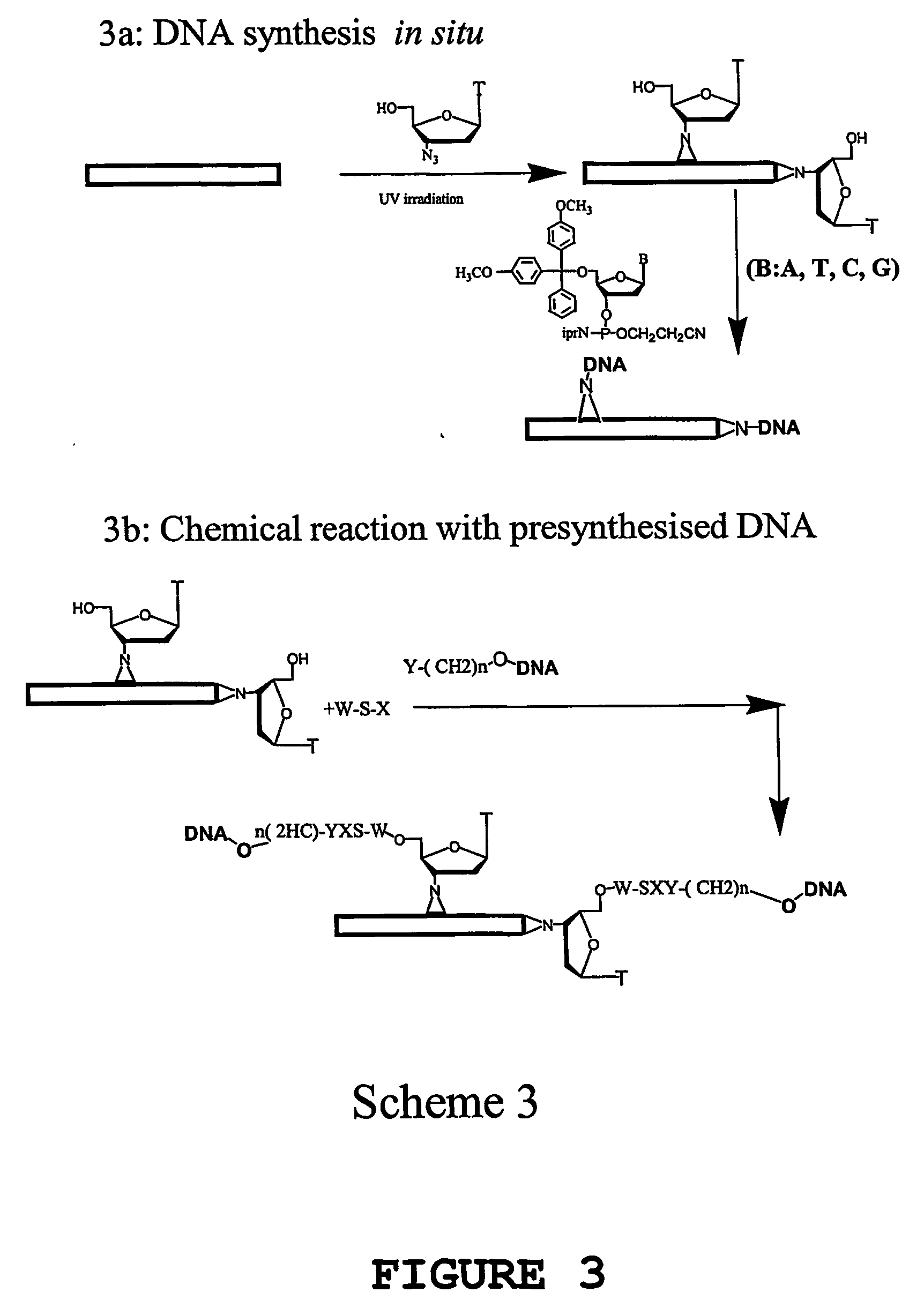Methods for the chemical and physical modification of nanotubes, methods for linking the nanotubes, methods for the directed positioning of nanotubes, and uses thereof
a technology nanotubes, which is applied in the field of chemical and physical modification of nanotubes, methods for linking nanotubes, and methods for directed positioning of nanotubes, and achieves the effect of increasing their usefulness
- Summary
- Abstract
- Description
- Claims
- Application Information
AI Technical Summary
Benefits of technology
Problems solved by technology
Method used
Image
Examples
example 1
Chemical and Physical Attachment of DNA to Carbon Nanotubes
[0192] Nucleic acid molecules have been covalently attached to carbon nanotubes using a number of different methods. The different strategies involved (1) aligned nanotubes or dispersed nanotubes, with different functional groups (hydroxyl or carboxyl) introduced predominantly on the tips of the nanotubes by chemical reaction, (2) aligned nanotubes, dispersed nanotubes, or mats of nanotubes, with functional groups introduced on to the nanotubes by photochemical reaction, using photoreactive functional groups such as azidothymidine, azido nitrobenzoyloxysuccinimide. In both strategies, the nucleic acid may be attached either by DNA synthesis in situ or by covalent coupling of pre-synthesised and functionalised DNA molecules to the nanotubes.
(1.1) In situ DNA Synthesis on Aligned, multi-walled Carbon Nanotubes with Functional OH / COOH Groups.
[0193] Aligned, MWNTs were grown on a quartz substrate, by pyrolysis of iron(II) ph...
example 2
Synthesis and Manipulation of DNA Molecules for Attaching to the Nanotubes and for Use in Assays to Determine the Status of DNA Attached to Nanotubes
[0224] DNA molecules were synthesised on an Applied Biosystems DNA synthesiser using the phosphoramidite method. The CPG-beads, with DNA attached, were tipped from the DNA-synthesiser columns into a glass vial, and 1-1.4 mL of ammonia solution was added. The glass vial was sealed, and heated at 55° C. for 8-10 hours. After cooling, the solution was transferred to a round-bottom flask, rotor-evaporated under vacuum to remove ammonia, and co-evaporated twice with autoclaved, milliQ water. The DNA was transferred with autoclaved water to an eppendorf tube, concentrated with sec-butanol, washed with ether, and pelleted on dry ice in 0.3M sodium acetate and 80% ethanol. The pellet was washed with 80% ethanol, dried under vacuum, redissolved in water, and stored frozen at −20° C.
[0225] The purity of each DNA oligomer was checked by labellin...
example 3
Determination of DNA Attachment onto Nanotubes
[0232] X-ray Photoelectron Spectroscopy (XPS) assays the chemical composition of a 10 nm surface layer. Thus, XPS can be used to determine if DNA is attached to the surface of nanotubes, particularly by detecting the presence of phosphorus, and increased amounts of nitrogen. However, it is not sufficiently sensitive to distinguish between DNA that is chemically attached or strongly physically adsorbed, nor can it reveal if the attached DNA is in a conformation that is able to bind its complementary strand. In order to characterise the DNA-modified nanotubes, XPS (Kratos Ultra Imaging XPS spectrometer, Mg ka at 150 W) was carried out. The results of these analyses are shown in Tables 1-3. The data shown in Table 1 are for the samples prepared in Example 1.1. The data shown in Table 2 are for the samples prepared in Example 1.2a for the 5′-amino modified DNA. In Table 3, the “fully treated” sample, which produced DNA chemically attached t...
PUM
| Property | Measurement | Unit |
|---|---|---|
| lengths | aaaaa | aaaaa |
| diameters | aaaaa | aaaaa |
| diameter | aaaaa | aaaaa |
Abstract
Description
Claims
Application Information
 Login to View More
Login to View More - R&D
- Intellectual Property
- Life Sciences
- Materials
- Tech Scout
- Unparalleled Data Quality
- Higher Quality Content
- 60% Fewer Hallucinations
Browse by: Latest US Patents, China's latest patents, Technical Efficacy Thesaurus, Application Domain, Technology Topic, Popular Technical Reports.
© 2025 PatSnap. All rights reserved.Legal|Privacy policy|Modern Slavery Act Transparency Statement|Sitemap|About US| Contact US: help@patsnap.com



